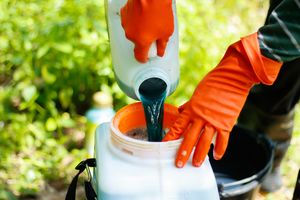KANBrief 1/24

Requirements, set out in standards, concerning gloves and clothing for protection against pesticides are less stringent than those for chemical-resistant gloves and clothing. INRS, the French occupational safety and health institute, has examined the differences more closely and expressed its concerns regarding the En ISO 27065 and ISO 18889 standards and the test methods required by them.
To fulfil their protective function, chemical-resistant gloves and clothing must form a physical barrier through which hazardous chemicals are unable to pass and reach the skin. To evaluate the effectiveness of this barrier, a range of harmonized European standards have been adopted over the last thirty years. They define types of chemical-resistant gloves and clothing, and the test methods and performance criteria to be met in the tests. Resistance to chemicals takes two forms: resistance to the passage of chemicals through pores, material defects and seams (penetration resistance), and resistance to the molecular diffusion of chemicals through the material (permeation resistance).
Besides these two mechanisms, contact with chemicals may also give rise to degradation processes. These can impair the mechanical strength of the material, favour the permeation of chemicals or even cause the material to break down.
In accordance with EN 374-2 and EN ISO 17491 Parts 3 and 4, standardized test liquids are used to assess the resistance of gloves and protective clothing to liquid chemicals. The test methods include visual testing for the passage of air (for gloves) or liquid (water in the case of gloves, standardized test liquid for clothing). EN ISO 6530 contains a special procedure for penetration testing on clothing that is not liquid-tight. This type of clothing is used where a risk exists only of small quantities of non-hazardous liquids being sprayed.
Resistance to permeation by a liquid at the molecular level is assessed in accordance with EN 16523-1 and EN ISO 6529 by means of a permeation cell. The cell is divided into two chambers by a sample from the personal protective equipment under test. Once the sample has been placed in contact with the liquid, permeation can be monitored as a function of time.
Resistance to degradation is more difficult to assess. To date, only one standard for this purpose has been published: EN ISO 374-4, governing gloves for protection against chemicals. However, this standard states by way of introduction that the degradation test described is to be supplemented by other tests to permit more precise assessment of the degradation processes.
EN ISO 27065 and ISO 18889 set out requirements for gloves and clothing worn by users of pesticides. They refer in turn to further standards describing test methods for chemical resistance that differ significantly from the reference test methods described above for chemical-protective gloves and clothing:
Furthermore, it is sufficient for the gloves and clothing to pass the new tests with only a single chemical in order to be certified against ISO 18889 and EN ISO 27065. The chemical in question is not even a pesticide, but merely a product claimed to be similar. In view of the chemical diversity of the pesticides available, this minimum requirement appears to be far from sufficient.
INRS is of the opinion that the path taken with the EN ISO 27065 and ISO 18889 product standards should not be pursued further, and that EN ISO 27065 should at least lose its status as a harmonized European standard. Instead, the existing standards for chemical-protective gloves and clothing should be used as a basis for the specification such products for protection against pesticides, including higher performance levels for certain properties, or additional performance criteria that are tailored more closely to the contact with pesticides. For example, high tear resistance or ergonomic criteria such as breathability are important parameters for the protection of workers in agriculture or similar sectors.
Full version of the article on the INRS study (in French):
A. Guilleux, D. Le Roy, N. Chabanne, F. Zimmermann, B. Berlioz, INRS
annabelle.guilleux@inrs.fr